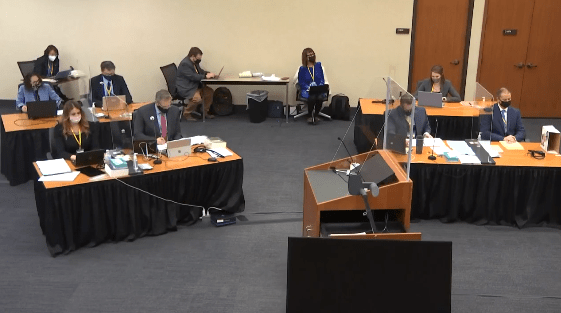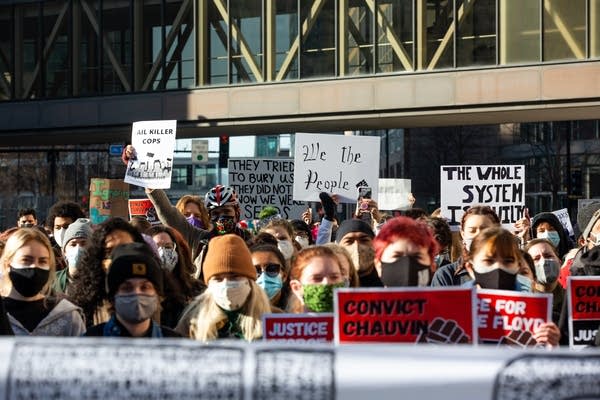Chauvin trial: Floyd restraint violated cops' training, ethics, chief says
Monday's court proceedings have ended for the day

Go Deeper.
Create an account or log in to save stories.
Like this?
Thanks for liking this story! We have added it to a list of your favorite stories.
MPR News is streaming live coverage of the trial. Some images or material discussed during the trial will be disturbing to many viewers. Watch the morning proceedings here. Watch the afternoon proceedings here.
3 things to know:
Minneapolis police chief testifies that Chauvin’s use of force to subdue Floyd was not reasonable and not within department policy
MPD homicide unit head called force used on Floyd “totally unnecessary”
Case expected to hinge on who or what is responsible for Floyd’s death
Updated 5:34 p.m.
Derek Chauvin should have ended his restraint of George Floyd once Floyd stopped resisting, the city’s police chief testified Monday in Chauvin’s murder and manslaughter trial.
“Once Mr. Floyd had stopped resisting, and certainly once he was in distress and trying to verbalize that, that should have stopped,” Medaria Arradondo told the court during his highly anticipated testimony.
“There is an initial reasonableness in trying to get him under control in the first few seconds,” he told jurors.
Turn Up Your Support
MPR News helps you turn down the noise and build shared understanding. Turn up your support for this public resource and keep trusted journalism accessible to all.
“But once there was no longer any resistance, and clearly when Mr. Floyd was no longer responsive and even motionless, to continue to apply that level of force to a person, proned out, handcuffed behind their back, that in no way shape or form is anything that is by policy,” he said. “It’s not part of our training, and it is certainly not part of our ethics or values.”
The chief said Chauvin’s use of force to subdue Floyd was not reasonable and not within department policy.
He noted that while the department allowed neck restraint, the training called for light to moderate pressure only, Chauvin’s maneuver was not light to moderate pressure. The police department banned chokeholds all together in the wake of Floyd's killing.
Arradondo also said Chauvin violated the city policy requiring officers to render medical aid.
Officers must also weigh the severity of the crime in their decision to use force on a suspect, along with assessing the immediate threat, he added. The call to police on Floyd came after Floyd allegedly handed a counterfeit $20 bill to a Cup Foods clerk to buy cigarettes.
Arradondo told the prosecution that he had first viewed video of the May 25 incident shot from an area municipal camera mounted at the intersection, which provided a distance view with no sound, and initially didn’t see anything that shocked him.
Around midnight, he said, hours after the incident, he said a “community member contacted me and said, ‘Chief have you seen the video of your officer choking and killing that man at 38th and Chicago?’”
Arradondo said he then found the bystander video with sound, showing Chauvin’s actions close-up as Floyd pleaded that he couldn’t breathe.
In cross-examining Arradondo, defense attorney Eric Nelson emphasized that department policy allowed unconscious and conscious neck restraints. He also pointed to body camera footage that appears to show Chauvin's knee on Floyd's shoulder blade when paramedics arrived.
The last person to take the stand Monday was Inspector Katie Blackwell, who headed the department's training unit last year. She explained to the to the jury that neck restraints were allowed. But under department policy, officers were only allowed to use their arms, she said.
As she looked at a photo of Chauvin kneeling on Floyd's neck, she told the court: “I don’t know what kind of improvised position that is. That’s not what we train.”
The police department banned chokeholds altogether in the wake of Floyd's killing. Blackwell will continue her testimony on Tuesday.
ER doctor recounts effort to revive Floyd

Monday began with testimony from the the doctor who pronounced Floyd dead last May. Dr. Bradford W. Langenfeld said that Floyd was in cardiac arrest when paramedics brought him to the emergency room and that Floyd showed only “pulseless electrical activity,” which he said signaled a lack of oxygen.
He testified that he theorized at the time that Floyd most likely died of asphyxiation. Langenfeld also said the paramedics did not tell him that Floyd had suffered a drug overdose or a heart attack.
The perspectives are important because Chauvin’s defense is arguing that the drugs in Floyd’s body and his underlying health problems caused his death.
Prosecutors are trying to prove that it was the ex-Minneapolis police officer’s actions — specifically his knee on Floyd’s neck — that killed Floyd, that the lack of oxygen was caused by compression on Floyd chest and neck by Chauvin.
Bystander video showed Chauvin with his knee pressed against Floyd’s neck for about nine minutes as the man lay handcuffed and face down on the street, pleading that he couldn’t breathe.

Under cross-examination, Langenfeld told Chauvin’s attorney that Floyd had high carbon dioxide levels, which can be caused by the drug fentanyl, and he agreed that when someone has high carbon dioxide level, they can have a sensation of shortness of breath.
‘Totally unnecessary’ force
Chauvin’s defense argues that Floyd’s death was caused from the drugs in his body and his underlying health problems and that Chauvin’s use of force was in sync with Minneapolis Police Department policy.
Arradondo and other key officers have called that argument into question.
On Friday, the head of the Minneapolis police homicide unit testified the use of force officers used on Floyd was “totally unnecessary.”
Lt. Richard Zimmerman told jurors that after reviewing the body camera footage of police’s fatal encounter with Floyd, he concluded the officers went too far.
“Pulling him down to the ground, face down, and putting your knee on the neck for that amount of time — it’s just uncalled for,” Zimmerman said. “I saw no reason why the officers felt they were in danger, if that’s what they felt, and that’s what they would have to feel to be able to use that kind of force.”

Standard training and policy calls for turning individuals in the prone position on their side, especially once they're handcuffed and no longer pose a threat to police officers, said Zimmerman, the most senior officer on the force.
He testified that once a person is handcuffed, the threat level against an officer falls. "If they become less combative," Zimmerman said, "the idea is to calm the person down, and if they are not a threat to you at that point you try to help them so that they're not as upset as they may have been in the beginning."
Chauvin’s supervising sergeant that night also testified last week that Chauvin initially told him only that Floyd “suffered a medical emergency” and nothing about keeping his knee pressed against Floyd’s neck.
He said Chauvin acknowledged the use of force on Floyd only after he’d met up with Chauvin at the hospital on the orders of a police lieutenant.
Using a knee is appropriate only until an officer is able to handcuff an individual, David Pleoger, now retired, told jurors. "When Mr. Floyd was no longer offering up any resistance to the officers, they could've ended the restraint.”

The most direct clue so far pointing to Chauvin’s mindset has come from the officer’s video. On Wednesday, prosecutors played footage from Chauvin’s body camera showing a man at the scene criticizing the officer afterward for the way he restrained Floyd.
“That's one person's opinion,” Chauvin responds on the video. “We gotta put force, gotta control this guy because he's a sizable guy. Looks like he's probably on something.”
Trial basics

Who’s who: A look at the key players in the trial.
Need to know: Key questions about the trial, answered.
What we know about the jurors: The 12 jurors and two alternates picked to review the case include a chemist, a youth volunteer, a cardiac nurse and an IT professional.
Chauvin's lawyer is outnumbered, but has help: No fewer than four attorneys have appeared for the prosecution so far, compared to a single attorney to defend Derek Chauvin.
Legion of Chauvin prosecutors, each with own role: Viewers may be struck by the array of prosecutors taking turns presenting their case. The choice of who does what is no accident.
MPR News on its coverage: Nancy Lebens, the newsroom’s deputy managing editor, answered audience questions about our reporting plans.
George Floyd and his legacy

Remembering George Floyd, the man: Before he became a symbol in the fight for racial justice, friends say Floyd was a “gentle giant” who sought a fresh start.
Making George Floyd Square: Here’s how the site of Floyd’s killing — 38th Street and Chicago Avenue in Minneapolis — is being reshaped.
Rescuing the plywood — and memorializing a movement: Two Black women are leading the effort to preserve the murals painted on storefront boards in the Twin Cities.
Calls for change: Here’s what some Floyd activists tell MPR News about their experiences with race in Minnesota, why they march and what they hope for the future.
Read more

Racism is making us sick. How can equity in medicine help us heal? Two doctors and a medical researcher talk about how racism affects their patients’ health — and how racism in medicine leads to inadequate medical education and poor care. (Sahan Journal)
Backers of Minneapolis public safety reform effort seek community support: Sunday was the final day backers of one the Yes 4 Minneapolis coalition could collect signatures to put their proposed city charter amendment before voters.
George Floyd Square hosts People's Power Love Fest: The event was part of a push to gather support for a proposal to replace the Minneapolis Police Department with a new Public Safety Department.
Witnesses relive trauma, guilt over Floyd's death: The first days of testimony at the Chauvin trial have been dominated by the witnesses to his arrest and countless videos that forced them to relive the trauma of it all over again. (The Associated Press)
Video dominates trial in George Floyd's death: A worldwide audience has been shown more than just the widely seen bystander video that set off nationwide protests last year. (The Associated Press)
NPR’s live blog: The latest from the murder trial of Derek Chauvin.



